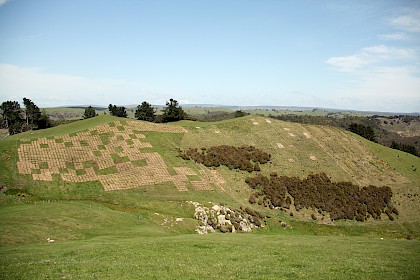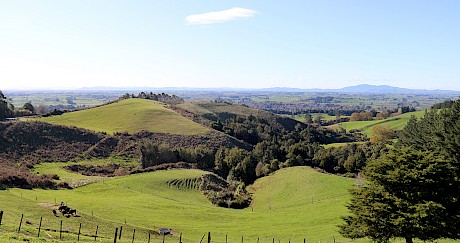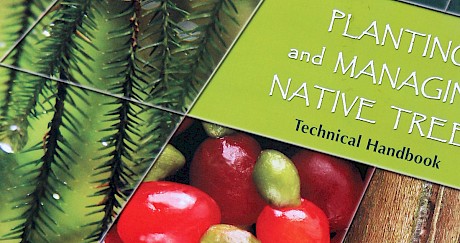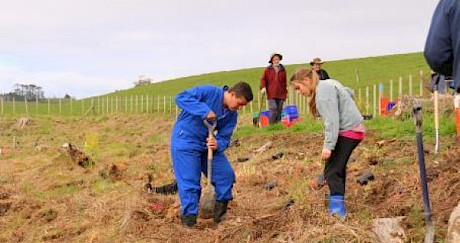Performance of open-ground and container-raised natives planted on hill country, Lake Taupo catchmentProject Status: Completed
Planting trials comparing the cost and growth performance of open-ground (bare-root) nursery stock versus container-raised seedlings was established on a hill country site in the Lake Taupo catchment, central North Island, New Zealand from 2009 to 2011. Trials tested a range of native shrub and monocotyledon species commonly used in revegetation programmes often used to provide a rapid cover to control weed growth and shelter for emerging inter-planted or naturally regenerating native tree species. Open-ground stock for most of these early successional species performed as well as seedlings of comparable size raised in PB3 containers. Growth of root trainer stock was in general slower than the other two stock types. Bare-root seedlings were less than half the cost of those raised in the PB3 planter bags, similar to that of the smaller Hillsons root trainer stock. Stock raised in PB3 containers required four times as much space for storage and transport to the planting site and took up to four times longer to distribute and plant than open-ground stock. Results indicate an opportunity to reduce the cost of establishing native forest on hill country sites using large nursery-raised bare-root seedlings.
This work is building on earlier work by the Forest Research Institute Nursery and on field trials established more recently in North Auckland and managed by the Mahurangi Action Group.
The project was funded by the Lake Taupo Protection Trust and TTT in collaboration with Scion, Future Forests Research, Taupo Native Plant Nursery and the Waikato Regional Council.
Background
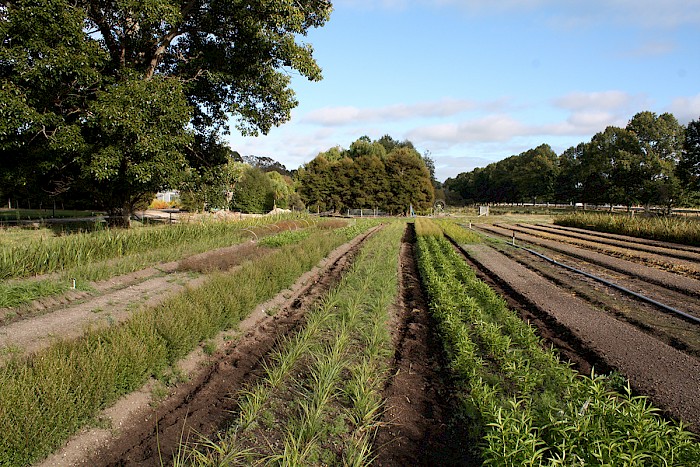 Figure 1: Open ground beds showing kanuka left, toetoe centre and hebe right at Taupo Native Plant Nursery, Taupo. A significant proportion of productive land within the Lake Taupo catchment is likely to be retired from pasture and planted in forestry. This will assist the realisation of the goal of the Lake Taupo Protection Trust (LTPT) to reduce the amount of nitrogen leaching into the lake by 20% over 15 years.
Figure 1: Open ground beds showing kanuka left, toetoe centre and hebe right at Taupo Native Plant Nursery, Taupo. A significant proportion of productive land within the Lake Taupo catchment is likely to be retired from pasture and planted in forestry. This will assist the realisation of the goal of the Lake Taupo Protection Trust (LTPT) to reduce the amount of nitrogen leaching into the lake by 20% over 15 years.
Options for landowners include exotic forestry as well as native forestry conservation or production. Impediments to the establishment of indigenous forest include slow growth of native tree species, high cost of seedlings, uneven plant quality, and high cost of weed control.
This project, managed by Tāne’s Tree Trust (TTT), aimed to provide practical guidelines for establishing a range of indigenous tree and shrub species on land retired from pastoral grazing or exotic production forestry within the Lake Taupo catchment. A specific objective was to reduce the cost of raising and establishing indigenous plants for large scale planting programmes.
Methods
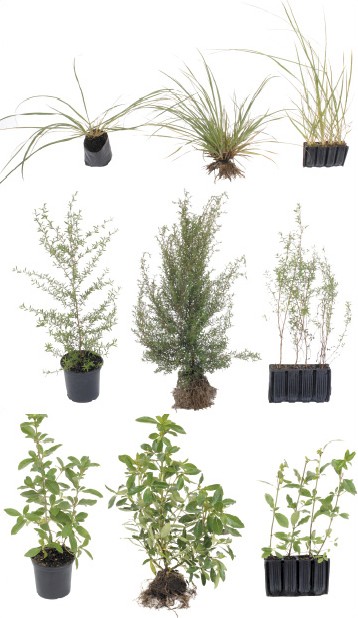 Figure 2: Toetoe (top), manuka (middle) and karamu (lower) plants raised for nine months in the larger PB3 containers or equivalent size plastic containers (left); in open-ground nursery beds (centre); and in smaller Hillson root trainers (right).Seedlings of shrub hardwood and monocotyledon species were raised within one year in the Taupo Native Plant Nursery in containers and as open-ground transplants using standard methods as described by Smith (2010). Two nursery stock type treatments were prepared for the first planting year in 2009 (open-ground, PB3 polythene planter bags), and three stock types for the second and third planting years 2010 and 2011 (open-ground, PB3 planter bags, root trainers) (Figures 1 & 2).
Figure 2: Toetoe (top), manuka (middle) and karamu (lower) plants raised for nine months in the larger PB3 containers or equivalent size plastic containers (left); in open-ground nursery beds (centre); and in smaller Hillson root trainers (right).Seedlings of shrub hardwood and monocotyledon species were raised within one year in the Taupo Native Plant Nursery in containers and as open-ground transplants using standard methods as described by Smith (2010). Two nursery stock type treatments were prepared for the first planting year in 2009 (open-ground, PB3 polythene planter bags), and three stock types for the second and third planting years 2010 and 2011 (open-ground, PB3 planter bags, root trainers) (Figures 1 & 2).
The selection of species trialled and numbers of seedlings raised for both nursery and field-based trials was dependent on seed available as organised by the Taupo Native Plant Nursery. Ten species were raised in the nursery for planting out with karamu (Coprosma robusta), koromiko (Hebe stricta var. stricta), manuka (Leptospermum scoparium), Coprosma propinqua, harakeke (Phormium tenax), Austroderia toetoe and A. fulvida in the first year, and kanuka (Kunzea ericoides var. ericoides) and kohuhu (Pittosporum tenuifolium) replacing Coprosma propinqua and A. fulvida in the second year and rautawhiri (Pittosporum colensoi) included in the third year. Totara (Podocarpus totara) and temporary nurse crop of radiata pine were also planted in the 2011 trial.
The planting site
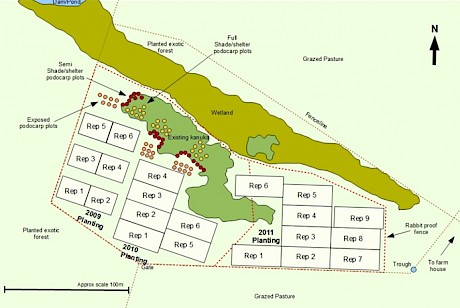 Figure 3: Layout of replicated blocks for the native species planting trials established in 2009, 2010 and 2011 comprising shrub hardwood and monocotyledon species, Waihaha, western Taupo.The planting trial was located on a west Taupo farm at Waihaha, central North Island, typical of steep pastoral land (Figure 3). The 4-ha site comprised a steep north facing hill side dominated by exotic pasture grasses with an adjacent riparian area. Approximately 10,000 native seedlings were planted in separate trials across the three years, with each year of planting retired from grazing immediately before planting (Figure 3 & 4).
Figure 3: Layout of replicated blocks for the native species planting trials established in 2009, 2010 and 2011 comprising shrub hardwood and monocotyledon species, Waihaha, western Taupo.The planting trial was located on a west Taupo farm at Waihaha, central North Island, typical of steep pastoral land (Figure 3). The 4-ha site comprised a steep north facing hill side dominated by exotic pasture grasses with an adjacent riparian area. Approximately 10,000 native seedlings were planted in separate trials across the three years, with each year of planting retired from grazing immediately before planting (Figure 3 & 4).
Monitoring of growth performance was undertaken over 5 years after the trials were established.
Conclusions
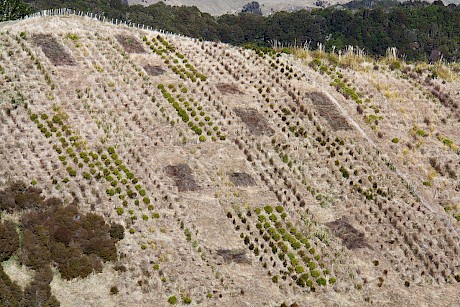 Figure 4: Planting trial 2 years after establishment as a Randomised Complete Block design comprising 12 tree rows comparing performance of 10 native species.In general, there was no significant difference in survival and growth within the first 5 years between plants raised open-ground and in the larger containers (1.2-litre pots and PB3 planter bags) for the shrub hardwood and monocot species trialled. Higher mortality rates and/or maintenance costs, and slower growth can be expected in plants raised in small containers (Hillson-sized root trainers) with losses largely due to spindly plants being overtopped by grass competition, especially where timely weed control is not carried out.
Figure 4: Planting trial 2 years after establishment as a Randomised Complete Block design comprising 12 tree rows comparing performance of 10 native species.In general, there was no significant difference in survival and growth within the first 5 years between plants raised open-ground and in the larger containers (1.2-litre pots and PB3 planter bags) for the shrub hardwood and monocot species trialled. Higher mortality rates and/or maintenance costs, and slower growth can be expected in plants raised in small containers (Hillson-sized root trainers) with losses largely due to spindly plants being overtopped by grass competition, especially where timely weed control is not carried out.
Open-ground stock is potentially half the cost ($0.50-$1.50) of the commonly produced larger container options ($2.50-$3.50). However, estimated ‘shelf life’ after lifting open-ground stock is very limited compared to container options so as with radiata pine planting operations, planting programmes using bare root seedlings of native seedlings requires stock to be planted with 2-3 days of lifting from the nursery.
A significant cost for large container stock is the space that it takes up during storage and transport compared to open-ground and the small root trainer stock. Plants raised in PB3 planter bags require at least four times the space for storage and transport compared to open-ground stock. Similar numbers of open-ground stock can be transported to the site and carried around the planting site as the root trainer stock.
The results indicate an opportunity to significantly reduce the cost of establishing planted native forests for most species using plants raised by the open-ground or bare-root nursery method.
Outputs
- Year 1 and Year 2 progress reports
- Smith, P. 2010: Reducing costs associated with establishment of native plants in the Lake Taupo catchment. In: Barton, I.; Gadgil, R.; Bergin, D. (Eds.): Managing native trees. Towards a national strategy. Proceedings of the Tāne’s Tree Trust 10th anniversary conference and workshops held at The University of Waikato, 18-20 November 2009. Tāne’s Tree Trust. 52-55.
Contacts for this project
- Dr David Bergin, Tāne’s Tree Trust
- Michael Bergin, Environmental Restoration Ltd

